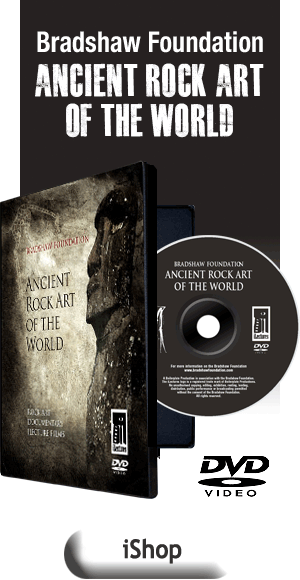 |
 |
GRUTA DEL ESPIRITU SANTO - THE MORAZAN DISTRICT OF EL SALVADOR |
The
Bradshaw Foundation was contacted in 2002 by Dr. Roberto Ticas of El Salvador, who wished to discuss the options for preservation and protection of the rock art of Corinto Cave. This was to be carried out under the auspices of Concultura [National Council of Culture & Art, based at the Museo Nacional de Antropologia Dr David J Guzman in San Salvador] with the archaeologist Marlon Escamilla.
Corinto Cave, located in the Lomas de Zuncuyo mountains of the eastern Morazan Department, is one of the principle rock art sites in Central America, and has been designated as a National Monument. The cave is located approximately 2kms north of the small market town of Corinto. The volcanic landscape is heavily forested. The cave is approximately 60m wide, 30m in height and 20m deep.
There are roughly 200 pictographs in the cave. The colours are red, ochre, black, green, yellow and white. The motifs are composed of figures and symbols. The human and animal motifs appear in a variety of poses. Some of the figures appear to wear plumed feather head-dresses. Two of the figures share a noticeable and characteristic elongated/curved left wrist.
Two snakes or zig-zag symbols
There are several hand stencils, using a white pigment as the background. The symbols vary in design. Some share a linear and right-angled appearance. There is an example of a perfect rectangle. Other symbols are curvilinear, with an example of a vulva motif. The pictographs show a variety of styles, which appear to be grouped in distinct 'galleries'.
 |
 |
 |
 |
 |
| Ostrich-like figure |
|
Crayfish-like figure |
|
Hand motif |
There is some degree of superimposition of paintings. The size of the paintings varies: the figures are roughly 30 cms in height, although some are up to 100 cms. The symbols vary from roughly 4 cms to 50 cms in height. The general appearance of the paintings is faded. Some sections of the cave have been covered by concretions caused by water seepage, which has led to the complete and partial covering of some of the pictographs.
The dating of the pictographs has not been confirmed, although it has been suggested that the rock art belongs to the 'Recent Classic' - 600 to 900 AD [Perrot-Minnot 2007]. Further archaeological analysis of the cave and the surrounding area will add more information to not only the dating of the rock art but the occupancy of the site within a prehistoric and PreColumbian context.
Human figure with staff or spear
 |
ARCHAEOLOGICAL PARK |
The Corinto Cave lies on the northern edge of a considerable volcanic conglomerate and tufa outcrop. The outcrop and its surroundings represent an area of archaeological and anthropological interest, hence Concultura's desire to develop it as a 'cultural centre'.
Two separate large holes have been created [or enhanced] in the overhanging cliff, suggesting the possible use for astrological purposes. There are standing stones with cupules and what appears to be a dolmen, remnants of an extinct lake/river system. An ancient Spanish road traverses the outcrop leaving deep cartwheel parallel tracks indicating travel and trade with Honduras to the north.
Deep Cartwheel Parallel Tracks
Exploring the area further, we visited an isolated petroglyph site located near the Honduras border, deep in the Baja Profundo jungle. Accessible only by foot, this site contains numerous distinct petroglyphs of figures and symbols, measuring from 5 cm to 25 cm in height. The site occupies one very large outcrop but may be more extensive subject to further investigation.
Also in the Baja Profundo another site, located at the base of a 100m volcanic cliff, contains two distinct styles and phases, the earlier of which resembles the rock art in the Corinto Cave. The later stage is represented by larger and fresher images with clear Mayan influence. The rock face at the site is deteriorating considerably.
 |
PRESERVATION & PROTECTION |
Further analysis and documentation - the Corinto Cave rock art site is extensive and must have complete systematic research and documentation. To date, there has occurred some tracing of some of the art, but new documentation should perhaps concentrate on digital imaging and enhancement. This should be consolidated by the mapping of the cave and the surrounding area.
Carbon Dating - in order to establish a time scale, dating of the rock art is essential. AMS carbon dating should be possible with the charcoal figures [it is necessary to have half a milligram of pure charcoal]. The samples [minimum of 2] should be 'blind'. Archaeological excavation should take place in the cave to cross-reference the dating. However, previous studies [not excavations] suggest that the water seepage may have distorted the underlying stratigraphy, thus invalidating any results.
Site deterioration - the site must be prevented from further deterioration, primarily by water seepage. There are two suggestions: tree planting above the cave [eucalyptus] and water diversion. However, there are precedents of problems with sudden environmental changes, such as the reduction or removal of moisture from the rock surface, resulting in subsidence and collapse. If there is seepage and water running, the water can be diverted by using elastomers to make derivations or false stalactites as has been done in the
Niaux Cave, France.
Protection, Management & Presentation - the rock art requires proximity for viewing. Some form of restricted walkway would allow for protection but enable presentation. The information could be provided by both written and digital means.
→
Bradshaw Foundation


























